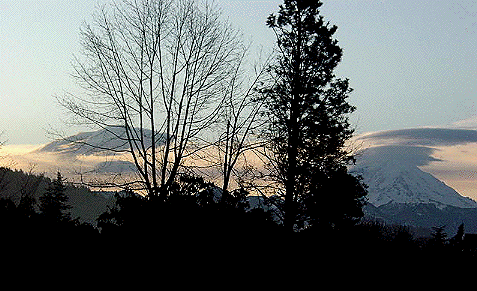 |
|
With the seasonal loss of oak leaves, it is possible to see a sister volcano to Mount Rainier (right.) Note the large glaciers on the upper left of the sister and right side of Rainier, the exposed rocks between glaciers on both, and the forested lower flanks of the two mountains. A band of clouds surrounds the lower portions on the sister and slides over the top of Rainier. Actually, the sister is a very unusual formation of different types of clouds. The mountain itself is an extremely dense cloud, with the contrasting highlight and shadow of sunrise making it appear solid. The illusion is intensified with lower, wispy clouds in the foreground. They stretch across to behind the pine tree. What appear to be rocks between the glaciers are the tree branches, out of context as perception is focused on the mountain. Rainier is capped by two ice crystal clouds that formed when moist air hits the frigid top of the real mountain. They are 14,000 to 16,000 feet high, far above the wispy clouds at the same level in the picture. Glaciers on the right and center of the mountain are separated by windblown rocks. This entire scene lasted for only a few minutes. |